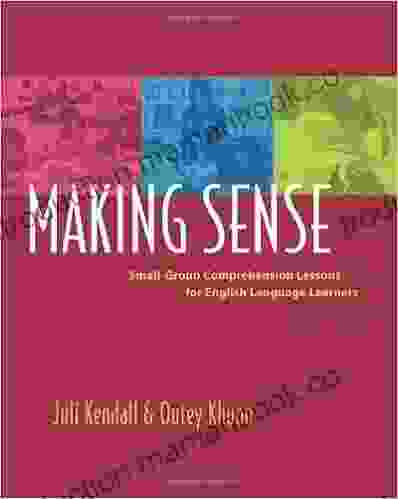Small Group Comprehension Lessons For English Language Learners: A Guide for Educators


Small group comprehension lessons are an effective way to help English language learners (ELLs) develop their reading skills. By providing targeted instruction in a small group setting, teachers can meet the individual needs of ELLs and help them make progress in their reading comprehension.
4.2 out of 5
| Language | : | English |
| File size | : | 3617 KB |
| Text-to-Speech | : | Enabled |
| Word Wise | : | Enabled |
| Print length | : | 168 pages |
| Lending | : | Enabled |
| Screen Reader | : | Supported |
This guide will provide educators with information on how to plan and implement small group comprehension lessons for ELLs. We will discuss the benefits of small group instruction, the different types of comprehension strategies that can be taught in small groups, and how to assess student progress.
Benefits of Small Group Comprehension Lessons
There are many benefits to using small group comprehension lessons with ELLs. Some of the benefits include:
- Individualized instruction: Small group instruction allows teachers to meet the individual needs of ELLs. Teachers can assess each student's reading level and comprehension skills and then provide targeted instruction that is appropriate for their needs.
- Increased student engagement: Small group instruction can be more engaging for ELLs than whole-group instruction. In a small group setting, students have more opportunities to participate and interact with the teacher and their peers.
- Improved comprehension: Small group comprehension lessons can help ELLs improve their comprehension skills. By providing targeted instruction in a supportive environment, teachers can help ELLs develop the skills they need to understand and comprehend text.
Types of Comprehension Strategies
There are many different comprehension strategies that can be taught in small groups. Some of the most common strategies include:
- Making predictions: Predicting what will happen next in a story can help students improve their comprehension. Teachers can teach students how to make predictions by asking them questions about the text and by having them summarize what they have read so far.
- Asking questions: Asking questions about the text can help students clarify their understanding. Teachers can teach students how to ask different types of questions, such as literal questions (who, what, when, where, why),inferential questions (what does this mean?),and evaluative questions (what do you think of this?).
- Making connections: Making connections between the text and their own experiences can help students improve their comprehension. Teachers can teach students how to make connections by asking them questions about their own lives and by having them share their thoughts and ideas.
- Summarizing: Summarizing a text can help students improve their comprehension and recall. Teachers can teach students how to summarize a text by asking them to identify the main points of the text and by having them write or draw a summary.
- Visualizing: Creating a mental image of the text can help students improve their comprehension. Teachers can teach students how to visualize by having them draw pictures, diagrams, or mind maps.
Planning Small Group Comprehension Lessons
When planning small group comprehension lessons, it is important to consider the following factors:
- Student needs: The first step is to assess the needs of your students. This can be done through formal assessments, such as reading tests, or informal assessments, such as observing students as they read. Once you know the needs of your students, you can plan instruction that is targeted to their specific needs.
- Instructional goals: Once you know the needs of your students, you can set instructional goals for your small group lessons. These goals should be specific, measurable, and achievable. For example, you might set a goal for your students to improve their ability to make predictions by 20%.
- Materials: The next step is to gather the materials you will need for your small group lessons. These materials might include texts, graphic organizers, manipulatives, and technology. It is important to choose materials that are appropriate for the needs of your students and that will help them achieve the instructional goals.
- Lesson procedures: Once you have gathered your materials, you can plan the procedures for your small group lessons. These procedures should be clear and concise and should allow for student engagement and interaction. It is important to plan for a variety of activities during your small group lessons, such as read-alouds, discussions, and hands-on activities.
- Assessment: The final step is to plan for assessment. Assessment should be used to track student progress and to make adjustments to instruction as needed. There are many different ways to assess student learning, such as formative assessments, such as observations and exit slips, or summative assessments, such as tests and projects.
Implementing Small Group Comprehension Lessons
Once you have planned your small group comprehension lessons, it is important to implement them effectively. Here are some tips for implementing small group comprehension lessons:
- Create a positive and supportive learning environment: It is important to create a positive and supportive learning environment for your small group lessons. This means creating a space where students feel safe to take risks and where they are encouraged to participate and share their thoughts and ideas.
- Set clear expectations: It is important to set clear expectations for students at the beginning of each small group lesson. This includes explaining the learning goals for the lesson and the procedures that will be followed.
- Provide explicit instruction: Explicit instruction is essential for teaching comprehension strategies to ELLs. This means providing clear and direct instruction on how to use a particular strategy. For example, you might demonstrate how to make a prediction by thinking aloud.
- Provide opportunities for practice: Students need opportunities to practice using comprehension strategies. This can be done through read-alouds, discussions, and hands-on activities. It is important to provide students with feedback on their use of comprehension strategies.
- Assess student progress: It is important to assess student progress regularly to track their progress and to make adjustments to instruction as needed. There are many different ways to assess student learning, such as formative assessments, such as observations and exit slips, or summative assessments, such as tests and projects.
Small group comprehension lessons are an effective way to help ELLs improve their reading skills. By providing targeted instruction in a small group setting, teachers can meet the individual needs of ELLs and help them make progress in their reading comprehension.
This guide has provided educators with information on how to plan and implement small group comprehension lessons for ELLs. We have discussed the benefits of small group instruction, the different types of comprehension strategies that can be taught in small groups, and how to assess student progress.
By following the tips in this guide, educators can help ELLs develop the comprehension skills they need to succeed in school and in life.
4.2 out of 5
| Language | : | English |
| File size | : | 3617 KB |
| Text-to-Speech | : | Enabled |
| Word Wise | : | Enabled |
| Print length | : | 168 pages |
| Lending | : | Enabled |
| Screen Reader | : | Supported |
Do you want to contribute by writing guest posts on this blog?
Please contact us and send us a resume of previous articles that you have written.
 Top Book
Top Book Novel
Novel Fiction
Fiction Nonfiction
Nonfiction Literature
Literature Paperback
Paperback Hardcover
Hardcover E-book
E-book Audiobook
Audiobook Bestseller
Bestseller Classic
Classic Mystery
Mystery Thriller
Thriller Romance
Romance Fantasy
Fantasy Science Fiction
Science Fiction Biography
Biography Memoir
Memoir Autobiography
Autobiography Poetry
Poetry Drama
Drama Historical Fiction
Historical Fiction Self-help
Self-help Young Adult
Young Adult Childrens Books
Childrens Books Graphic Novel
Graphic Novel Anthology
Anthology Series
Series Encyclopedia
Encyclopedia Reference
Reference Guidebook
Guidebook Textbook
Textbook Workbook
Workbook Journal
Journal Diary
Diary Manuscript
Manuscript Folio
Folio Pulp Fiction
Pulp Fiction Short Stories
Short Stories Fairy Tales
Fairy Tales Fables
Fables Mythology
Mythology Philosophy
Philosophy Religion
Religion Spirituality
Spirituality Essays
Essays Critique
Critique Commentary
Commentary Glossary
Glossary Bibliography
Bibliography Index
Index Table of Contents
Table of Contents Preface
Preface Introduction
Introduction Foreword
Foreword Afterword
Afterword Appendices
Appendices Annotations
Annotations Footnotes
Footnotes Epilogue
Epilogue Prologue
Prologue Christen Brown
Christen Brown A William Place
A William Place A W Hartoin
A W Hartoin Franka Hughes
Franka Hughes Omer Ziaee
Omer Ziaee Sharone Stevens
Sharone Stevens Luciana Lee
Luciana Lee Jay Allan
Jay AllanElla Gershon
 Ethel Johnston Phelps
Ethel Johnston Phelps Wolcott Wheeler
Wolcott Wheeler Rebecca Jenshak
Rebecca Jenshak Kass Thomas
Kass Thomas A L Herbert
A L Herbert Malcolm Surridge
Malcolm Surridge Kasey Michaels
Kasey Michaels Kareem Rosser
Kareem Rosser A J Odasso
A J Odasso Denys Geel
Denys Geel David Rabe
David Rabe
Light bulbAdvertise smarter! Our strategic ad space ensures maximum exposure. Reserve your spot today!
 Corbin PowellFollow ·4.2k
Corbin PowellFollow ·4.2k Dwayne MitchellFollow ·16.4k
Dwayne MitchellFollow ·16.4k Holden BellFollow ·17.7k
Holden BellFollow ·17.7k Chadwick PowellFollow ·7.8k
Chadwick PowellFollow ·7.8k Terry BellFollow ·13k
Terry BellFollow ·13k John SteinbeckFollow ·5.6k
John SteinbeckFollow ·5.6k Jay SimmonsFollow ·9.2k
Jay SimmonsFollow ·9.2k Ismael HayesFollow ·11.8k
Ismael HayesFollow ·11.8k

 Floyd Powell
Floyd PowellTutoring the Player Campus Wallflowers: A Comprehensive...
College campuses are...

 Chuck Mitchell
Chuck MitchellThe Beginner's Guide to Building, Repairing, Raising, and...
Credit is a...

 Deacon Bell
Deacon BellDelve into the Dangerous World of Motorrad Clubs with the...
Prepare yourself...

 Adrien Blair
Adrien BlairDiscover the Enchanting Allure of Living in the...
The Appalachian Forest, a verdant tapestry of...
4.2 out of 5
| Language | : | English |
| File size | : | 3617 KB |
| Text-to-Speech | : | Enabled |
| Word Wise | : | Enabled |
| Print length | : | 168 pages |
| Lending | : | Enabled |
| Screen Reader | : | Supported |














